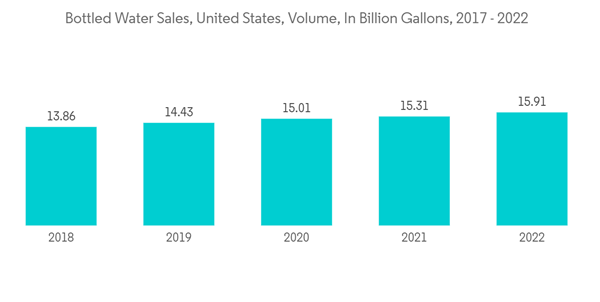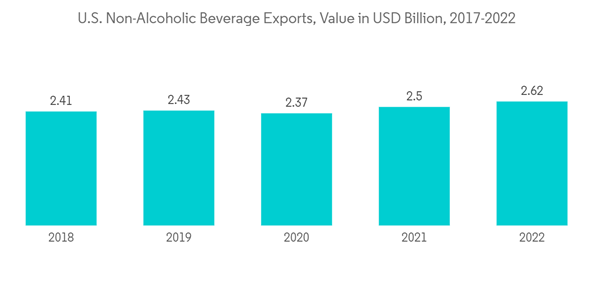The North American rigid plastic packaging market was valued at USD 54.67 billion in the previous year. It is expected to register a CAGR of 1.33% during the forecast period to become USD 59.46 billion by the next five years. As the consumption and production of goods in the consumer and industrial sectors continue to grow, the demand for rigid plastic packaging materials that can withstand harsh conditions without compromising the product's quality is increasing.
In February 2023, Berry Global launched a fully accredited combination of 28mm Neck PET Bottles for Pharmaceutical Syrup for the first time. The Berry Healthcare bundle includes seven ranges of PET Bottles in sizes ranging from 20ml up to 1000ml and a wide selection of designs. The bottles are accompanied by eight accompanying closures, each of which features tamper-easing and child-resilient features. Customers are able to choose the bottle and associated closure with liner and dosing cup to suit their specific application and capacity needs.
In September 2022, Berry Global teamed up with Mars Incorporated to bring recycled content packaging to the market. The two companies worked together by creating new packaging for M&M's, Skittles, and Starbursts that used 15% recycled plastics. The jars were available in three sizes - 60, 81, and 87 ounces - and were expected to help cut down on virgin plastic by around 300 tons each year.
This product will be delivered within 2 business days.
Key Highlights
- The plastic bottle market in the United States is projected to experience a steady increase in demand due to the growing consumption of plastic-based containers and their industrial applications. According to the Plastics Industry Association, the market for plastic bottles in the United States continues to expand.
- According to the LCA (Life Cycle Assessment) presented by the National Association for PET Container Resources, NAPCOR (National Association for the Packaging Industry of the United States, Canada, and Mexico), the negative environmental impact of PET bottles is significantly lower than that of the glass and aluminum containers. PET plastic packaging is used in over 70% of beverage bottles because of its lightweight, transparent, and 100% recyclable properties. PET plastic containers produce less solid waste than glass and aluminum containers, consume less water during manufacturing, and generate fewer emissions associated with acid rain and smog emissions.
- The need to recycle PET into food-grade products, like beverage containers, is a growing concern for many global companies. This can lead to an increase in demand for PET across the region. For example, according to a recent report, Coca-Cola aims to use 50 percent recycled PET in its containers by 2030. Unilever, for example, aims to make 100% of its plastic packaging recyclable or reusable by 2025.
- However, the use of plastic will likely slow down over time as people become more aware of environmental issues. More and more people in the United States and Canada are switching to environmentally friendly packaging materials. Governments in these countries have imposed stringent rules and regulations on plastics and plastic products due to their potentially harmful environmental effects. This has made it a relatively slow-growing industry compared to other materials.
- The Russia-Ukraine conflict has pushed raw plastic materials prices high. The conflict has led to economic sanctions, high commodity prices, energy costs, and supply chain disruption. The competition has affected many markets worldwide, including the North American market. Multiple companies have shut down their business or plants in Russia. Further, the increased oil prices are pushing plastic resin prices higher throughout the world supply chain, with energy prices initially reaching unprecedented levels. Commodities prices in the region have risen due to the conflict, resulting in inflation and hampering the economic recovery in North America.
North America Rigid Plastic Packaging Market Trends
Polyethylene Terephthalate (PET) is Expected to Witness Significant Growth
- The use of PET plastic bottles is expanding its range of applications. There is a growing need for PET packaging in both the bottled segment and the soft water segment. There are already a variety of creative, cost-effective, and eco-friendly packaging options available. PET is a well-known material that offers a range of advantages, such as shatterproofness, non-reactivity when in contact with drinks, and a high strength-to-weight ratio. Additionally, its lightweight properties provide cost savings when transporting products with PET packaging. PET is a secure material for beverage products and has been approved by the Food and Drug Administration (FDA) in the United States, as well as similar regulatory bodies throughout North America.
- The United States agricultural exports have been on a steadily increasing trajectory between 2017 and 2022, as reported by the U.S. Department of Agriculture (USDA), the United States Census Bureau (USCBO), and the United States Department of Commerce (USDOT). In 2017, the volume of agricultural exports reached USD 144.8 billion, while in 2020, the volume decreased to USD 139.7 billion. On the other hand, in 2022, the volume of the country's agricultural exports reached USD 196.4 billion, indicating an increase in demand. As a result, there is a potential for increased demand for rigid plastic packaging materials for the preservation and transportation of agricultural goods.
- According to ITA in May 2022, Canada's robust economy provides a credible market for U.S. cosmetics companies looking to enter and expand into the cosmetics market. The industry includes personal care products such as soaps, cosmetics, etc. In 2021, the Canadian cosmetics market was expected to be approximately USD 1.24 billion. The revenue of the industry is projected to increase by 1.45% per annum to USD 1.8 billion by the year 2024. The Canadian beauty and personal care industry represents a significant opportunity for U.S. cosmetics exporters. Emerging market trends are contributing to the growth of Canadian beauty products, including tailoring products to consumers' age, gender, and ethnicity using technology to enhance marketing strategies. Such factors drive the market for PET Rigid plastic packaging in the country.
- In 2022, the United States Bottled Water sales volume was estimated to be around 16 billion gallons. Over the past decade, the sales volume of United States bottled water has grown steadily each year. With the increasing demand for Bottled Water, there is demand for PET Bottles as a preferred material for Bottled Water because it is lightweight, durable, and recyclable. As the sales of bottled water are expected to increase with the past trend, it will aid the sales of PET Bottles, helping the market of PET rigid plastic in the region.
United States to Occupy Major Share
- The food sector is a major contributor to the rigid plastic industry in the region. As people become more aware of their health, the demand for healthy drinks is on the rise. As personal incomes have increased, bottled water has become a more attainable option for individuals, thus contributing to the expansion of the rigid plastics market.
- E-commerce spending in the United States is rising, driven by the convenience of home delivery, merchants' omnichannel capabilities, and contextual customer experiences. According to the U.S. Department of Commerce, e-commerce sales were USD 1.03 trillion in 2022, a 7.44% increase over 2021 and an 18.44% increase over 2020. E-commerce represented 19.3% of all retail sales in 2022 in the United States.
- The development of the rigid plastic packaging market is likely to be significantly impacted by the growth of food and beverage retail stores. As the consumption of food and beverages increases, so does the demand for packaging materials and solutions to meet that demand. The U.S. Census Bureau estimated that retail sales of food and beverages in the U.S. amount to approximately USD 947 billion in 2022.
- The United States Department of Agriculture (USDA) estimated that in 2022, the annual sales of Non-Alcoholic beverages in the United States might amount to approximately USD 2.64 billion. As the demand for Non-Alcoholic beverages increases, the demand for rigid plastic packaging materials, such as containers, bottles, and caps, for the packaging and distribution of these beverages is likely to increase. This could lead to an increase in the demand and production of rigid plastic packaging materials for North American non-alcoholic beverage manufacturers.
North America Rigid Plastic Packaging Industry Overview
Rigid plastic packaging is a highly competitive market. Companies strive to offer lightweight, high-performance plastic grades to lower costs and enhance packaging performance. Some of the most prominent players in rigid plastic packaging are Berry Global Inc., Amcor Group GmbH, Alpla Werke Alwin Lehner GmbH & Co KG, Silgan Holdings, Seal Air Corporation, Plastipak Holding, Sonoco Products Company, and Graham Packaging Company Inc., among others.In February 2023, Berry Global launched a fully accredited combination of 28mm Neck PET Bottles for Pharmaceutical Syrup for the first time. The Berry Healthcare bundle includes seven ranges of PET Bottles in sizes ranging from 20ml up to 1000ml and a wide selection of designs. The bottles are accompanied by eight accompanying closures, each of which features tamper-easing and child-resilient features. Customers are able to choose the bottle and associated closure with liner and dosing cup to suit their specific application and capacity needs.
In September 2022, Berry Global teamed up with Mars Incorporated to bring recycled content packaging to the market. The two companies worked together by creating new packaging for M&M's, Skittles, and Starbursts that used 15% recycled plastics. The jars were available in three sizes - 60, 81, and 87 ounces - and were expected to help cut down on virgin plastic by around 300 tons each year.
Additional Benefits:
- The market estimate (ME) sheet in Excel format
- 3 months of analyst support
This product will be delivered within 2 business days.
Table of Contents
1 INTRODUCTION
4 MARKET INSIGHTS
5 MARKET DYNAMICS
6 MARKET SEGMENTATION
7 COMPETITIVE LANDSCAPE
Methodology

LOADING...










